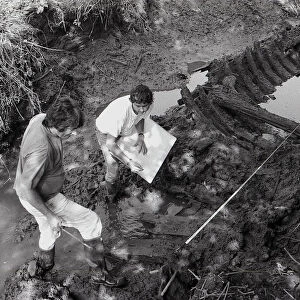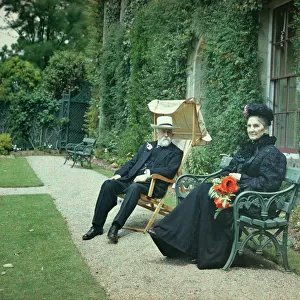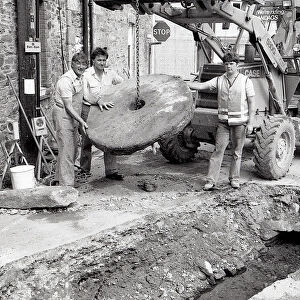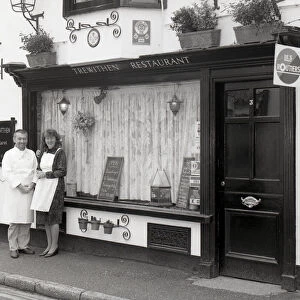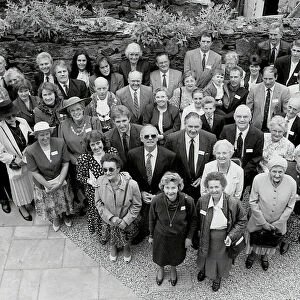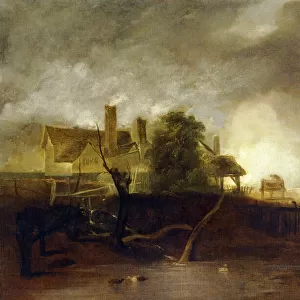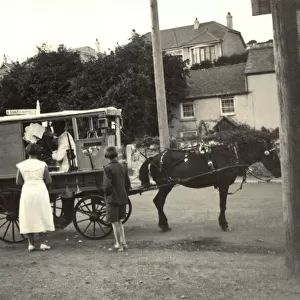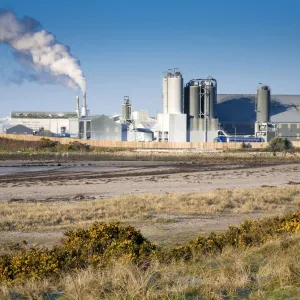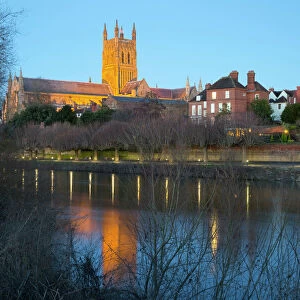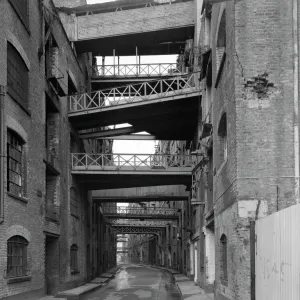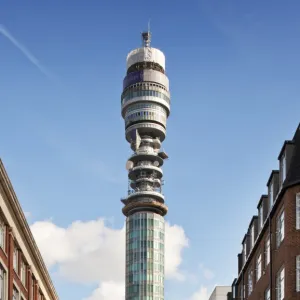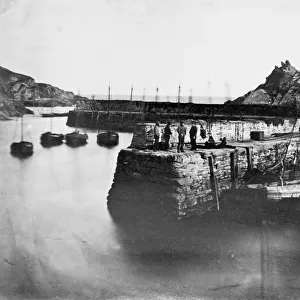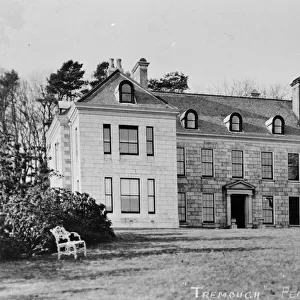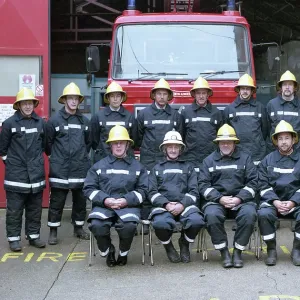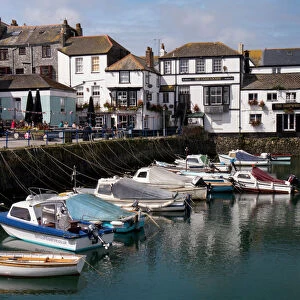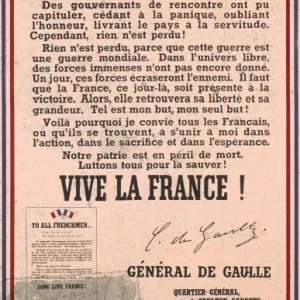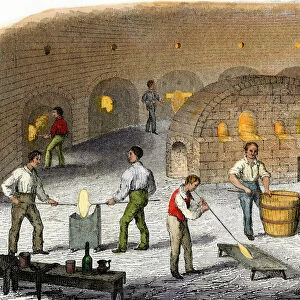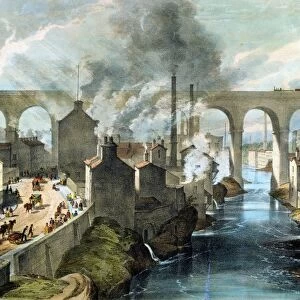Metal Print > Europe > United Kingdom > England > Herefordshire > Ledbury > Charles II
Metal Print : Limekiln, Quay Street, Lostwithiel, Cornwall. 1980
![]()

Metal Prints from Royal Cornwall Museum
Limekiln, Quay Street, Lostwithiel, Cornwall. 1980
A general view of the limekiln. The Grade II listed limekiln is thought to date from the early-mid 19th century. Building work is underway and the store and office to the left are being converted into a house. The kiln in the photograph is termed a draw kiln, usually of stone structure. The chalk or limestone was layered with wood, coal or coke and lit. As it burned through, lime was extracted from the bottom of the kiln, through the draw hole. These are the three arches to the right of the houses being converted. The kilns were loaded at the top and access to load was usually by a ramped track or, as in this case, probably just a track as the kilns are built into the side of rising ground at the rear. Early on, the coal and lime stone would be delivered to the harbour by ship, but as the industrial revolution and and railways spread it is likely that coal and lime stone arrived by rail. Kilns made 25-30 tonnes of lime in a batch. Typically the kiln took a day to load, three days to fire, two days to cool and a day to unload, so a one-week turnaround was normal. Because it is so readily made by heating limestone, lime must have been known from the earliest times and all early civilisations used it in building mortars and as a stabiliser in mud renders and floors. Knowledge of its value in agriculture is also ancient, but agricultural use only became widely possible when the use of coal lowered the cost. Photographer: Charles Woolf
Royal Cornwall Museum is the UK's Greatest Museum For Cornish Life & Culture
TRURI : LOStn.12
Media ID 18842327
© RIC, photographer Charles Woolf
Architecture Building Greenham History Industrial Industry Joyce Town
20"x24" (61x51cm) Metal Print
Step back in time with our stunning Metal Print of Limekiln, Quay Street, Lostwithiel, Cornwall from the Royal Cornwall Museum. This captivating image showcases the historic Grade II listed limekiln, believed to date from the early-mid 19th century. With construction work in progress and the store in the background, this print transports you to a bygone era. Our high-quality Metal Prints are known for their vibrant colors, long-lasting durability, and sleek modern design. Add this unique piece to your home decor and bring the rich history of Lostwithiel, Cornwall into your living space.
Made with durable metal and luxurious printing techniques, our metal photo prints go beyond traditional canvases, adding a cool, modern touch to your space. Wall mount on back. Eco-friendly 100% post-consumer recycled ChromaLuxe aluminum surface. The thickness of the print is 0.045". Featuring a Scratch-resistant surface and Rounded corners. Backing hangers are attached to the back of the print and float the print 1/2-inch off the wall when hung, the choice of hanger may vary depending on size and International orders will come with Float Mount hangers only. Finished with a brilliant white high gloss surface for unsurpassed detail and vibrance. Printed using Dye-Sublimation and for best care we recommend a non-ammonia glass cleaner, water, or isopropyl (rubbing) alcohol to prevent harming the print surface. We recommend using a clean, lint-free cloth to wipe off the print. The ultra-hard surface is scratch-resistant, waterproof and weatherproof. Avoid direct sunlight exposure.
Made with durable metal and luxurious printing techniques, metal prints bring images to life and add a modern touch to any space
Estimated Image Size (if not cropped) is 50.8cm x 60.9cm (20" x 24")
Estimated Product Size is 51.4cm x 61.5cm (20.2" x 24.2")
These are individually made so all sizes are approximate
Artwork printed orientated as per the preview above, with portrait (vertical) orientation to match the source image.
FEATURES IN THESE COLLECTIONS
> Architecture
> Harbours
> Architecture
> Related Images
> Europe
> United Kingdom
> England
> Cornwall
> Grade
> Europe
> United Kingdom
> England
> Cornwall
> Lostwithiel
> Europe
> United Kingdom
> England
> Cornwall
> Related Images
> Europe
> United Kingdom
> England
> Herefordshire
> Ledbury
> Charles II
> Historic
> Industrial revolution
> Railways
> Historic
> Industrial revolution
> Royal Cornwall Museum
> Places
> Lostwithiel
EDITORS COMMENTS
This print captures Limekiln, Quay Street in Lostwithiel, Cornwall in the year 1980. The image showcases a general view of the limekiln, which is believed to have been built during the early-mid 19th century and holds Grade II listed status. In this photograph, we witness ongoing construction work as the store and office on the left-hand side are being transformed into a residential house. The kiln featured in this picture is known as a draw kiln, typically constructed with stone materials. To produce lime, layers of chalk or limestone were stacked along with wood, coal or coke and ignited. As it burned through, lime was extracted from the bottom of the kiln through a draw hole located within three arches seen on the right side of the converted houses. Historically, these kilns were loaded from above using either ramped tracks or simple tracks like those found here since they were built into rising ground at their rear. Initially delivered by ship to the harbor, coal and limestone transportation transitioned to rail during industrialization. Each batch produced by these kilns yielded approximately 25-30 tonnes of lime. The process involved one day for loading, three days for firing, two days for cooling down and finally one day for unloading – resulting in an average turnaround time of one week. Lime has played a crucial role throughout history as it was used not only in building mortars but also as a stabilizer in mud renders and floors across various ancient civilizations. Its agricultural significance became more widespread when coal usage reduced its cost significantly.
MADE IN THE USA
Safe Shipping with 30 Day Money Back Guarantee
FREE PERSONALISATION*
We are proud to offer a range of customisation features including Personalised Captions, Color Filters and Picture Zoom Tools
FREE COLORIZATION SERVICE
You can choose advanced AI Colorization for this picture at no extra charge!
SECURE PAYMENTS
We happily accept a wide range of payment options so you can pay for the things you need in the way that is most convenient for you
* Options may vary by product and licensing agreement. Zoomed Pictures can be adjusted in the Cart.




